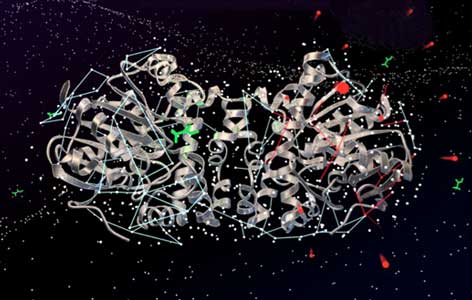Home page Description:
Study reveals the molecular acrobatics used by enzymes to break chemical bonds.
Posted On: February 13, 2017

Image Caption:
An illustration of the symmetrical structure of the enzyme fluoroacetate dehalogenase, which releases bound water molecules (red) when it binds to the pesticide fluoroacetate (green).
In the cell, enzymes work to make the seemingly impossible possible: by building or breaking chemical bonds, they can transform toxins into harmless molecules or release chemical energy to fuel the cell.
Despite their fundamental role in life, exactly how enzymes work remains a mystery. This is because it remains challenging to visualize the microscopic and rapid changes that occur at the scale of molecules.
A recent study led by PM Cancer Centre Senior Scientist Emil Pai and University of Toronto Professor Scott Prosser has shed light on enzyme function by using advanced imaging, spectroscopy and computational techniques.
The research team focused on a particular enzyme called fluoroacetate dehalogenase, which binds to and breaks down the toxic pesticide fluoroacetate. The team chose this enzyme because of its relatively slow action; it only breaks down several molecules per minute, whereas other enzymes can break down hundreds of thousands per minute.
The three-dimensional structure of fluoroacetate dehalogenase has two chemically identical regions known as ‘subunits’ (as depicted in the image). The study results showed that only one of these subunits can interact with a pesticide molecule at any given time. Furthermore, when the pesticide molecule binds to one of these subunits, the unused subunit becomes jittery, making the enzyme less symmetrical releasing water molecules— two processes that were found to be critical for enabling the enzyme to do its job.
Dr. Pai comments, “By revealing the changes that take place on a millisecond scale, this work reveals how the various parts of the enzyme work together—including the portions not directly involved in binding—for proper enzyme function.”
This work was supported by the Canadian Institutes of Health Research, the Natural Sciences and Engineering Research Council of Canada, the Canada Foundation for Innovation, the Ontario Research Fund and The Princess Margaret Cancer Foundation.
Kim TH, Mehrabi P, Ren Z, Sljoka A, Ing C, Bezginov A, Ye L, Pomès R, Prosser RS, Pai EF. The role of dimer asymmetry and protomer dynamics in enzyme catalysis. Science. 2017 Jan 20. doi: 10.1126/science.aag2355.
Despite their fundamental role in life, exactly how enzymes work remains a mystery. This is because it remains challenging to visualize the microscopic and rapid changes that occur at the scale of molecules.
A recent study led by PM Cancer Centre Senior Scientist Emil Pai and University of Toronto Professor Scott Prosser has shed light on enzyme function by using advanced imaging, spectroscopy and computational techniques.
The research team focused on a particular enzyme called fluoroacetate dehalogenase, which binds to and breaks down the toxic pesticide fluoroacetate. The team chose this enzyme because of its relatively slow action; it only breaks down several molecules per minute, whereas other enzymes can break down hundreds of thousands per minute.
The three-dimensional structure of fluoroacetate dehalogenase has two chemically identical regions known as ‘subunits’ (as depicted in the image). The study results showed that only one of these subunits can interact with a pesticide molecule at any given time. Furthermore, when the pesticide molecule binds to one of these subunits, the unused subunit becomes jittery, making the enzyme less symmetrical releasing water molecules— two processes that were found to be critical for enabling the enzyme to do its job.
Dr. Pai comments, “By revealing the changes that take place on a millisecond scale, this work reveals how the various parts of the enzyme work together—including the portions not directly involved in binding—for proper enzyme function.”
This work was supported by the Canadian Institutes of Health Research, the Natural Sciences and Engineering Research Council of Canada, the Canada Foundation for Innovation, the Ontario Research Fund and The Princess Margaret Cancer Foundation.
Kim TH, Mehrabi P, Ren Z, Sljoka A, Ing C, Bezginov A, Ye L, Pomès R, Prosser RS, Pai EF. The role of dimer asymmetry and protomer dynamics in enzyme catalysis. Science. 2017 Jan 20. doi: 10.1126/science.aag2355.




